Grievance Response Letter
[Your Name]
[Your Address]
[City, State, Zip Code]
[Email Address]
[Phone Number]
[Today's Date]
[Recipient's Name]
[Recipient's Job Title]
[Company/Organization Name]
[Address]
[City, State, Zip Code]
Subject: Response to Grievance Letter
Dear [Recipient's Name],
I hope this letter finds you well. I am writing in response to the grievance letter I received from you on [date], which outlined your concerns and dissatisfaction regarding [nature of the grievance]. I want to assure you that your feedback is important to us, and we take matters like this seriously.
We deeply regret any inconvenience or distress this situation may have caused you. Our primary goal is to provide exceptional service and satisfaction to all our valued [customers/clients/employees], and we acknowledge that we may not have met your expectations in this instance.
After a thorough investigation into the matter, we have identified the root causes of the issue and have taken immediate steps to address them. Allow me to outline the measures we have implemented:
1. Improved Communication Channels: We have revamped our communication channels to ensure that [customers/clients/employees] receive timely and accurate information. This includes providing clear guidelines on how to address grievances and ensuring that they reach the appropriate channels promptly.
2. Staff Training: We have conducted additional training sessions for our staff to enhance their communication skills, conflict resolution, and empathy when dealing with sensitive matters.
3. Review of Policies and Procedures: Our team has reviewed the relevant policies and procedures to identify any shortcomings and make necessary updates to prevent similar grievances from occurring in the future.
4. Feedback Mechanism: We have established a new feedback mechanism to allow [customers/clients/employees] to share their experiences, concerns, and suggestions, enabling us to continuously improve our services.
I want to personally apologize for the inconvenience you experienced, and I assure you that we are committed to learning from this situation and preventing it from recurring. Your satisfaction is of utmost importance to us, and we value your continued support and trust in our [products/services/organization].
Please feel free to reach out to us if you have any further questions, concerns, or suggestions. We are here to listen and address any remaining issues promptly.
Thank you for bringing this matter to our attention, and I look forward to your continued relationship with us.
Sincerely,
[Your Name]
[Your Job Title]
[Company/Organization Name]
Formal Grievance Response Letter
Subject: Response to Your Grievance
Dear [Employee Name],
We acknowledge receipt of your grievance submitted on [Date] regarding [Brief Description of Issue]. After a thorough review, we have taken the necessary steps to investigate the matter.
Based on our findings, [Summary of Findings/Actions Taken]. We assure you that appropriate measures have been implemented to address the concern.
Thank you for bringing this to our attention. Please feel free to contact HR if you require further clarification.
Sincerely,
[HR Manager Name]
[Company Name]
[Contact Information]
Provisional Grievance Response Letter
Subject: Provisional Response to Your Grievance
Dear [Employee Name],
We have received your grievance regarding [Issue] submitted on [Date]. At this time, we are conducting a detailed investigation and will provide a final response upon completion.
This provisional letter serves as an acknowledgment of receipt and our commitment to address your concerns promptly.
Thank you for your patience.
Sincerely,
[HR Manager Name]
[Company Name]
Informal Grievance Response Email
Hi [Employee Name],
Thanks for sharing your concern about [Issue]. We've looked into it and are working on the best way to resolve it. We'll keep you updated as we proceed.
Please reach out if you have additional details or suggestions.
Best,
[HR/Manager Name]
Grievance Response Letter with Resolution
Subject: Resolution to Your Grievance
Dear [Employee Name],
Following your grievance regarding [Issue], submitted on [Date], we have completed our review. The investigation confirmed [Findings] and the following actions have been taken to resolve the matter:
1. [Action 1]
2. [Action 2]
3. [Action 3]
We appreciate your patience during this process and encourage you to provide feedback if further concerns arise.
Sincerely,
[HR Manager Name]
[Company Name]
Heartfelt Grievance Response Letter
Subject: Response to Your Concern
Dear [Employee Name],
We understand the concerns you raised in your grievance dated [Date]. We genuinely value your feedback and have taken the matter seriously. Our team has implemented [Actions Taken] to ensure such issues are minimized going forward.
Your dedication to improving our workplace is greatly appreciated. Thank you for bringing this to our attention.
Warm regards,
[HR Manager Name]
[Company Name]
Quick Grievance Acknowledgment Email
Hi [Employee Name],
We have received your grievance regarding [Issue] submitted on [Date]. This is to confirm that we are reviewing the matter and will respond with a detailed update soon.
Thank you for notifying us.
Regards,
[HR/Manager Name]
Formal Grievance Rejection Response
Subject: Response to Your Grievance Submission
Dear [Employee Name],
We have carefully reviewed your grievance submitted on [Date] concerning [Issue]. Based on our investigation and company policies, we regret to inform you that the grievance cannot be upheld at this time.
We encourage you to continue providing feedback and assure you that all concerns are valued.
Sincerely,
[HR Manager Name]
[Company Name]
What is a Grievance Response Letter and Why It Is Important
A Grievance Response Letter is an official communication issued by an organization or HR department in reply to an employee's formal grievance.
Purpose:
- Provides formal acknowledgment and resolution of employee concerns.
- Ensures compliance with organizational policies and labor regulations.
- Enhances transparency and trust between employees and management.
Who Should Send a Grievance Response Letter
- Human Resources department or HR managers.
- Immediate supervisors or team leads when appropriate.
- Designated grievance redressal officers in large organizations.
Whom the Grievance Response Letter Should Be Addressed To
- Employees who have submitted the grievance.
- Internal committees handling employee relations.
- External parties if legally or organizationally required.
When to Send a Grievance Response Letter
- Upon receipt of an employee grievance.
- After completion of an investigation regarding the grievance.
- During interim updates, when only provisional feedback is available.
- Upon implementing corrective actions or resolutions.
How to Write and Issue a Grievance Response Letter
- Begin with acknowledgment of the grievance and its submission date.
- Clearly state the findings of any investigation conducted.
- Specify actions taken or the rationale if the grievance is not upheld.
- Use professional and empathetic language to maintain trust.
- Close with a polite offer for further communication or clarification.
- Choose the appropriate medium: email for quick acknowledgment, letter for formal resolution.
Formatting Guidelines for Grievance Response Letters
- Length: Concise, 150–300 words for clarity and impact.
- Tone: Professional, empathetic, and neutral; formal for official resolution.
- Style: Structured with headings or bullet points for actions taken.
- Mode: Email for internal updates, printed letter for formal HR documentation.
- Etiquette: Respectful, neutral, avoids assigning blame publicly.
Requirements and Prerequisites Before Sending a Grievance Response Letter
- Complete investigation of the grievance.
- Review of organizational policies and legal compliance.
- Consultation with relevant departments or committees.
- Documentation of findings and actions taken.
- Determination of appropriate tone and medium for communication.
Elements and Structure of a Grievance Response Letter
- Subject line clearly stating it is a grievance response.
- Salutation addressing the employee by name.
- Acknowledgment of grievance receipt and reference details.
- Summary of findings or review conducted.
- Actions taken or explanation if grievance is not upheld.
- Polite closing with contact information for follow-up.
- Signature of HR or authorized officer.
Common Mistakes to Avoid in Grievance Response Letters
- Delayed response causing frustration or loss of trust.
- Using defensive or accusatory language.
- Omitting key details of the investigation or actions taken.
- Not providing a clear path for further follow-up.
- Failing to document the response officially in HR records.
Tricks and Tips for an Effective Grievance Response Letter
- Respond promptly to acknowledge receipt of grievance.
- Maintain a professional and empathetic tone throughout.
- Use bullet points to outline steps taken or planned actions.
- Keep a copy for HR records to ensure accountability.
- Provide clear contact points for any additional concerns.
FAQ About Grievance Response Letters
Q: How long should an organization take to respond to a grievance?
A: Ideally within 7–14 business days, depending on the complexity of the issue.
Q: Can a grievance be partially accepted?
A: Yes, response letters can acknowledge valid aspects while explaining areas not upheld.
Q: Is a formal letter always required?
A: Not always; emails may suffice for internal updates, but formal letters are preferred for final resolutions.
Q: Can employees appeal a grievance response?
A: Yes, most organizations have an escalation process or grievance appeal mechanism.
After Sending a Grievance Response Letter
- Ensure the employee acknowledges receipt of the response.
- Follow up on implementation of corrective actions if applicable.
- Maintain documentation in HR records for future reference.
- Address any further questions or clarifications from the employee promptly.

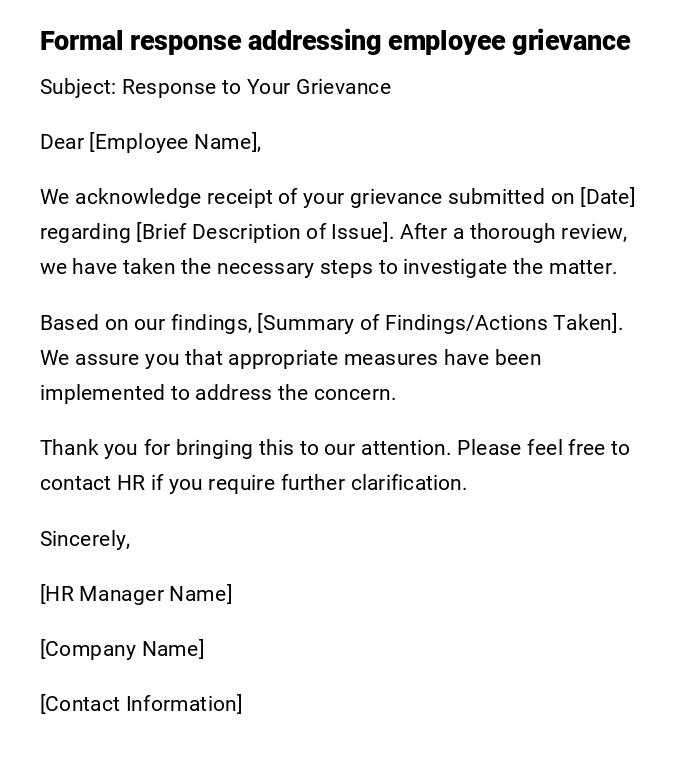
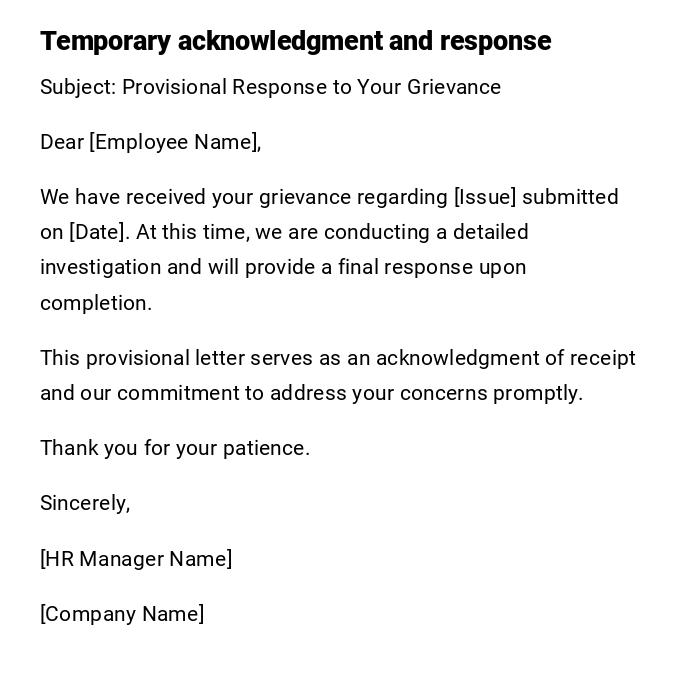
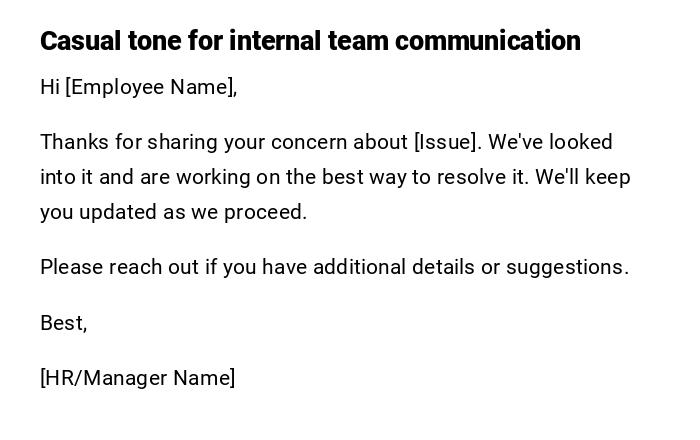
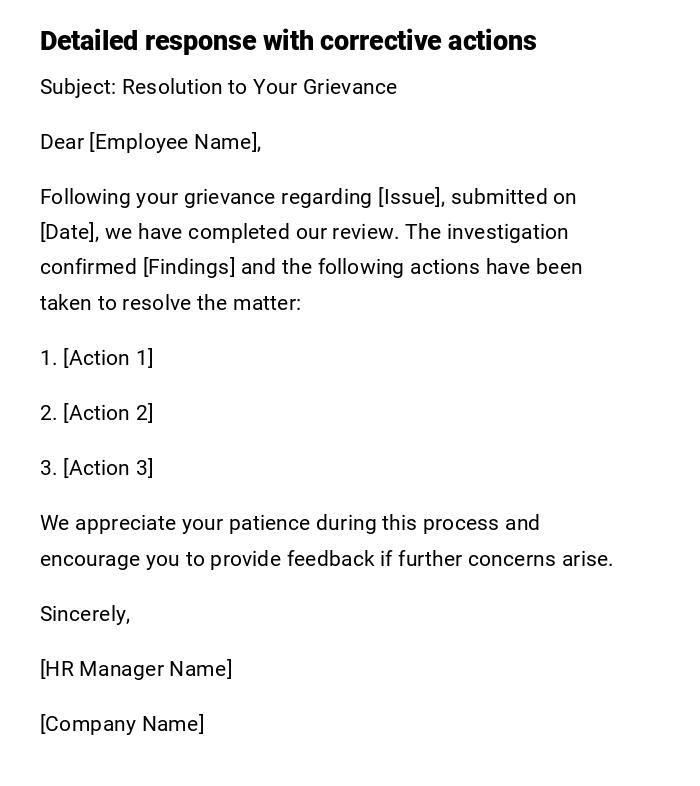
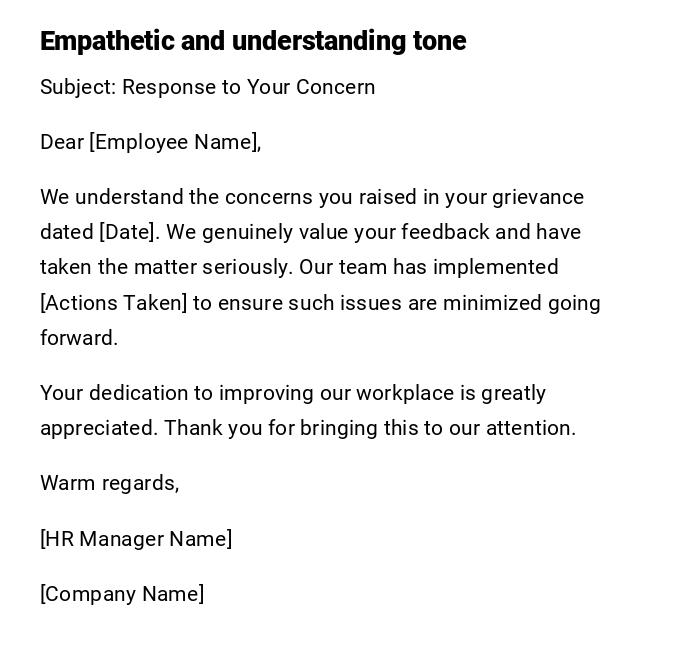
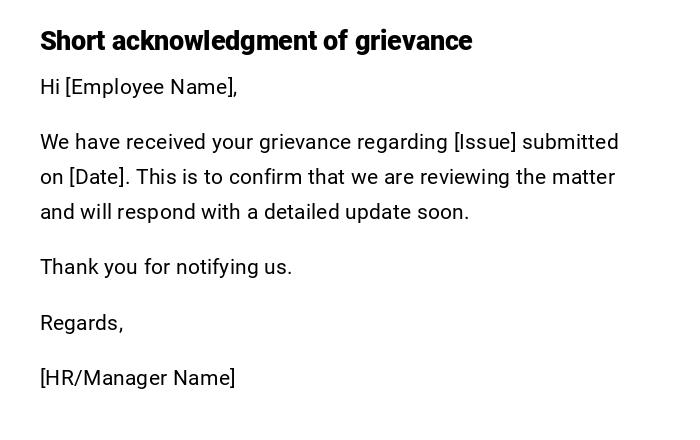
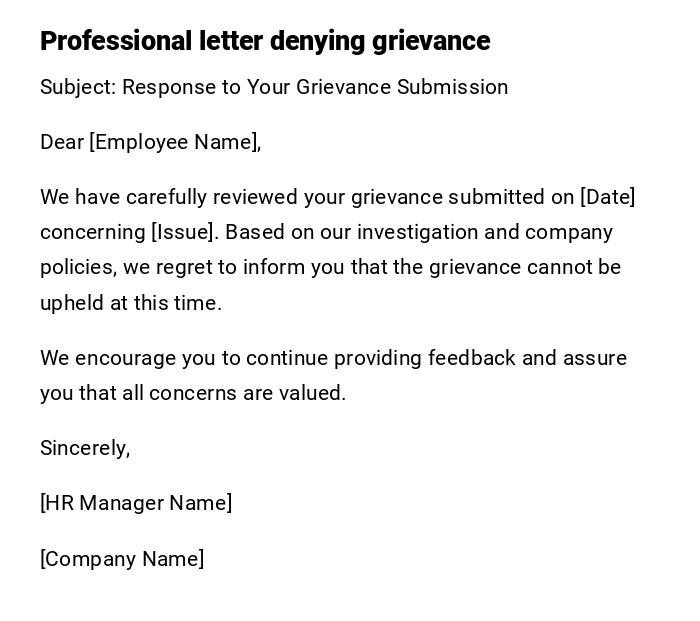

 Download Word Doc
Download Word Doc
 Download PDF
Download PDF